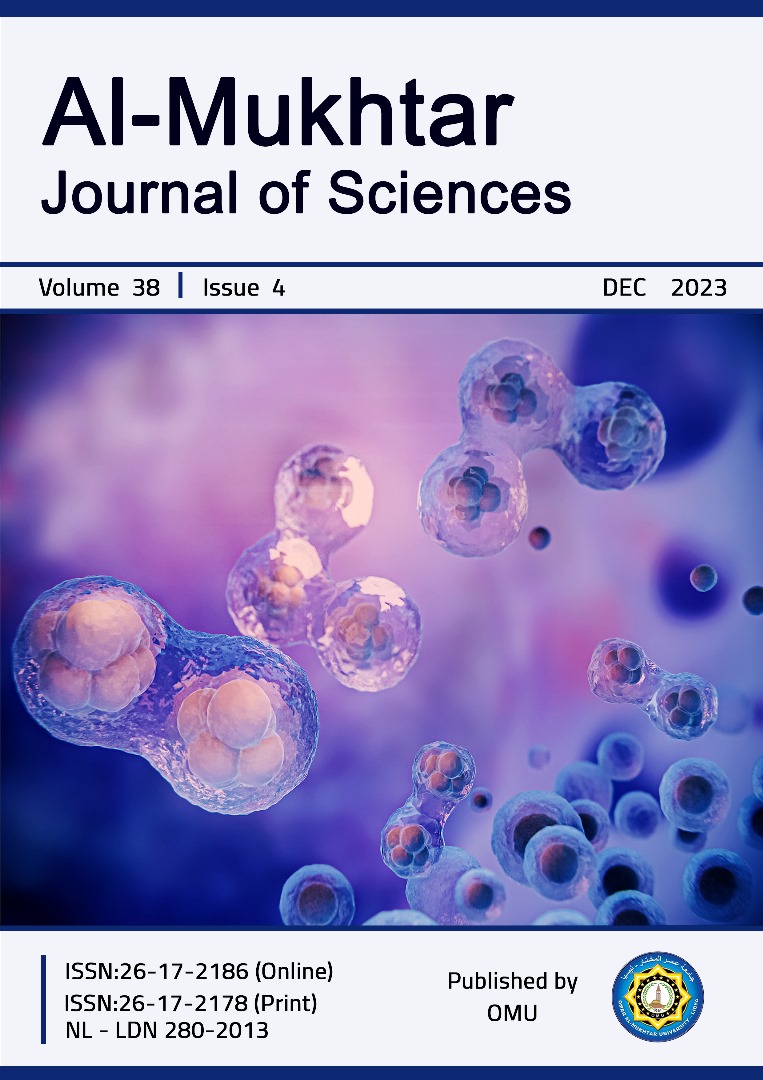Designing an Inhibitor Molecule to Combat Cancer through the Inhibition of Mutant PI3K (P110 α) Subunit Protein
- Authors
-
-
Esmaiel I. F. Saad
Department of Microbiology, Faculty of Science, Omar Al Mukhtar University, LibyaAuthor
-
- Keywords:
- PI3k, Modeller, Molecular, Docking, PyRx
- Abstract
-
The PI3K pathway plays a crucial role in the development of various types of cancers. Specifically, the P110 α component is frequently modified in the formation of human cancer, leading to disruptions in cell growth regulation and the emergence of malignancies. This research paper delves into the increasing utilization of computational tools to forecast potential molecules capable of inhibiting cancer. To validate stable structures of PI3K (P110α) component protein models, the study employed Ramachandran map analysis, which revealed active regions in close proximity to the mutation site. Through the employment of PyRX software, molecular docking studies were conducted, resulting in the identification of four inhibitor derivatives that exhibited significant effectiveness with the lowest docking energies in preventing the mutated PI3K (P110 α) component protein structures. Furthermore, these inhibitors adhered to Lipinski's rule of five, further enhancing their potential.
- Downloads
-
Download data is not yet available.
- References
-
An, X., Bai, Q., Bing, Z., Liu, H., Zhang, Q., Liu, H., & Yao, X. (2020). Revealing the Positive Binding Cooperativity Mechanism between the Orthosteric and the Allosteric Antagonists of CCR2 by Metadynamics and Gaussian Accelerated Molecular Dynamics Simula-tions. ACS chemical neuroscience, 11(4), 628–637.
Apel A. Robert K.Y. Cheng R.K.Y. Tautermann C. H. Brauchle M., Huang C. Pautsch A., Hen-nig M., Nar H.and Schnapp G.(2019). Crystal Structure of CC Chemokine Receptor 2A in Complex with an Orthosteric Antagonist Provides Insights for the Design of Selective An-tagonists.Structure, 27(3): 427-438.e5.
Bassani, D., and Moro, S. (2023). Past, Present, and Future Perspectives on Computer-Aided Drug Design Methodologies. Molecules (Basel, Switzerland), 28(9), 3906.
Berman, H. M., Westbrook, J., Feng, Z., Gilliland, G., Bhat, T. N., Weissig, H.,... Bourne, P. E. (2000). The Protein Data Bank. Nucleic Acids Research, 28(1), 235-242.
Bickerton, G. R., Paolini, G. V., Besnard, J., Muresan, S., & Hopkins, A. L. (2012). Quantifying the chemical beauty of drugs. Nature Chemistry, 4(2), 90-98.
Cantley, L. C. (2002). The phosphoinositide 3-kinase pathway. Science, 296(5573), 1655-1657.
Cheol-Min P. Tetsuro O. Andrew M. Petros A.M. Haichao Zhang H., Nimmer P. M. Henry R. F. and Elmore S. W.(2006).Design, Synthesis, and Computational Studies of Inhibitors of Bcl-XL. Journal of American Chemical Societ.128 (50): 16206 –16212.
Colovos, C., & Yeates, T. O. (1993). Verification of protein structures: Patterns of nonbonded atomic interactions. Protein Science, 2(9), 1511-1519.
Engelman, J. A., Luo, J., & Cantley, L. C. (2006). The evolution of phosphatidylinositol 3-kinases as regulators of growth and metabolism. Nature Reviews Genetics, 7(8), 606-619.
Garcia-Echeverria, C., & Sellers, W. R. (2008). Drug discovery approaches targeting the PI3K/Akt pathway in cancer. Oncogene, 27(41), 5511-5526.
Garner, T. P., Lopez, A., Reyna, D. E., Spitz, A. Z., & Gavathiotis, E. (2017). Progress in targeting the BCL-2 family of proteins. Current opinion in chemical biology, 39, 133–142.
Ikenoue, T., Kanai, F., Hikiba, Y., Obata, T., Tanaka, Y., Imamura, J.,... Matsumoto, K. (2005). Functional analysis of PIK3CA gene mutations in human colorectal cancer. Cancer Re-search, 65(11), 4562-4567.
Isakoff, S. J., Engelman, J. A., & Irie, H. Y. (2005). Breast cancer-associated PIK3CA mutations are oncogenic in mammary epithelial cells. Cancer Research, 65(23), 10992-11000.
Janku, F., Lee, J. J., Tsimberidou, A. M., Hong, D. S., Naing, A., & Falchook, G. S. (2011). PIK3CA mutations frequently coexist with RAS and BRAF mutations in patients with ad-vanced cancers. PLoS One, 6(7), e22769.
Jin, Z., Zhao, Y., Sun, Y., Zhang, B., Wang, H., Wu, Y.,... Yang, H. (2021). Structural basis for the inhibition of SARS-CoV-2 main protease by antineoplastic drug carmofur. Nature Structural and Molecular Biology, 28, 529-535.
Jorgensen, W. L. (2004). The many roles of computation in drug discovery. Science, 303(5665), 1813-1818.
Kang, S., Bader, A. G., & Vogt, P. K. (2005). Phosphatidylinositol 3-kinase mutations identified in human cancer are oncogenic. Proceedings of the National Academy of Sciences, 102(3), 802-807.
Khan, S., Fakhar, Z., Hussain, A., Ahmad, A., Jairajpuri, D. S., Alajmi, M. F., & Hassan, M. I. (2022). Structure-based identification of potential SARS-CoV-2 main protease inhibi-tors. Journal of biomolecular structure & dynamics, 40(8), 3595–3608.
Kim, S., Park, H. S., & Oh, B. H. (2022). Computational design of an apoptogenic protein that binds BCL-xL and MCL-1 simultaneously and potently. Computational and structural bio-technology journal, 20, 3019–3029.
Laskowski, R. A., MacArthur, M. W., Moss, D. S., & Thornton, J. M. (1993). PROCHECK: A pro-gram to check the stereochemical quality of protein structures. Journal of Applied Crystal-lography, 26(2), 283-291.
Lee, J. W., Soung, Y. H., Kim, S. Y., Nam, H. K., Park, W. S., Nam, S. W.,... Kim, S. H. (2005). PIK3CA gene is frequently mutated in breast carcinomas and hepatocellular carcinomas. Oncogene, 24(8), 1477-1480.
Lipinski, C. A., Lombardo, F., Dominy, B. W., & Feeney, P. J. (1997). Experimental and computa-tional approaches to estimate solubility and permeability in drug discovery and development settings. Advanced Drug Delivery Reviews, 23(1-3), 3-25.
Lovell, S. C., Davis, I. W., & Arendall, W. B. III. (2003). Structure validation by Cα geometry: φ, ψ and Cβ deviation. Proteins: Structure, Function, and Bioinformatics, 50(3), 437-450.
Moens, U., Kostenko, S., & Sveinbjørnsson, B. (2013). The Role of Mitogen-Activated Protein Ki-nase-Activated Protein Kinases (MAPKAPKs) in Inflammation. Genes, 4(2), 101–133.
Muryshev, A. E., Tarasov, D. N., Butygin, A. V., Butygina, O. Y., Aleksandrov, A. B., & Nikitin, S. M. (2003). A novel scoring function for molecular docking. Journal of computer-aided molecular design, 17(9), 597–605.
Osweihr W.S M. and. Saad E. I. (2022) Identification of an Inhibitor Molecule for CancerCausing Src Mutant Protein using in silico Analysis. Libyan Journal of Basic Sciences. Vol. 19(3) No. 33-45.
Patra, M. C., Maharana, J., Dehury, B., & De, S. (2014). Computational insights into the binding mechanism of antagonists with neuropeptide B/W receptor 1. Molecular bioSystems, 10(8), 2236–2246.
Pearce, L. R., Komander, D., & Alessi, D. R. (2008). The nuts and bolts of AGC protein kinases. Nature Reviews Molecular Cell Biology, 11(1), 9-22.
Pinzi, L., & Rastelli, G. (2019). Molecular Docking: Shifting Paradigms in Drug Discov-ery. International journal of molecular sciences, 20 (18), 4331.
Pires, D. E., Blundell, T. L., & Ascher, D. B. J. J. o. m. c. (2015). pkCSM: predicting small-molecule pharmacokinetic and toxicity properties using graph-based signatures. 58(9), 4066-4072.
Saad, E. I. (2017). Drug Design for Cancer-Causing PI3K (P110 α) subunit Mutant Protein. Interna-tional Journal of Pharmacy & Life Sciences, 8(11).
Saad IF. and Almabruk AA. (2022). Tracking evolution of collagen subfamily for its utmost possi-ble benefit. Al-Jabal Academy Journal of Pure and Applied Sciences. 1(1); 41-49.
Saad, E. I. and Attitalla H. (2017). Molecular Dynamic Simulation and an Inhibitor Prediction of PI3K (P110 α) Subunit Mutant Protein Structured Model as a Potential Drug Target for Cancer. Vol. 1 No. 1:
Sali, A., Potterton, L., Yuan, F., van Vlijmen, H., & Karplus, M. (1995). Evaluation of comparative protein modeling by Modeller. Proteins: Structure, Function, and Genetics, 23(3), 318-326.
Samad, A., Ajmal, A., Mahmood, A., Khurshid, B., Li, P., Jan, S. M., Rehman, A. U., He, P., Abdalla, A. N., Umair, M., Hu, J., & Wadood, A. (2023). Identification of novel inhibitors for SARS-CoV-2 as therapeutic options using machine learning-based virtual screening, mo-lecular docking and MD simulation. Frontiers in molecular biosciences, 10, 1060076.
Samuels, Y., and Ericson, K. (2006). Oncogenic PI3K and its role in cancer. Current Opinion in Oncology, 18(1), 77-82.
Samuels, Y., Wang, Z., Bardelli, A., Silliman, N., Ptak, J., Szabo, S.,... Velculescu, V. E. (2004). High frequency of mutations of the PIK3CA gene in human cancers. Science, 304(5670), 554.
Sen, D., Debnath, P., Debnath, B., Bhaumik, S., & Debnath, S. (2022). Identification of potential inhibitors of SARS-CoV-2 main protease and spike receptor from 10 important spices through structure-based virtual screening and molecular dynamic study. Journal of bio-molecular structure & dynamics, 40(2), 941–962.
Shah, V. P., Midha, K. K., Dighe, S., McGilveray, I. J., Skelly, J. P., Yacobi, A.,... Viswanathan, C. T. (2002). Analytical methods validation: Bioavailability, bioequivalence and pharmacoki-netic studies. Journal of Pharmaceutical Sciences, 91(1), 1-10.
Sliwoski, G., Kothiwale, S., Meiler, J., & Lowe, E. W., Jr (2013). Computational methods in drug discovery. Pharmacological reviews, 66(1), 334–395.
Ton, A. T., Gentile, F., Hsing, M., Ban, F., & Cherkasov, A. (2020). Rapid Identification of Poten-tial Inhibitors of SARS-CoV-2 Main Protease by Deep Docking of 1.3 Billion Com-pounds. Molecular informatics, 39(8), e2000028.
Uniyal, A., Mahapatra, M. K., Tiwari, V., Sandhir, R., & Kumar, R. (2022). Targeting SARS-CoV-2 main protease: structure based virtual screening, in silico ADMET studies and molecular dynamics simulation for identification of potential inhibitors. Journal of biomolecular struc-ture & dynamics, 40(8), 3609–3625.
von Bubnoff, N., Peschel, C., and Duyster, J. (2005). Resistance of Philadelphia-chromosome posi-tive leukemia towards the kinase inhibitor imatinib (STI571, Glivec): A targeted oncoprotein strikes back. Leukemia, 19(8), 1437-1442.
Yuan, T. L., and Cantley, L. C. (2008). PI3K pathway alterations in cancer: Variations on a theme. Oncogene, 27(41), 5497-5510.
Zhao, H., and Vogt, P. K. (2008). Helical domain and kinase domain mutations in p110α of phos-phatidylinositol 3-kinase induce gain of function by different mechanisms. Proceedings of the National Academy of Sciences, 105(7), 2652-2657.
Zunder, E. R., Knight, Z. A., and Shokat, K. M. (2008). Discovery of drug-resistant and drug-sensitizing mutations in the oncogenic PI3K isoform p110α. Cancer Cell, 14(2), 180-192.
- Downloads
- Published
- 2023-12-31
- Issue
- Vol. 38 No. 4 (2023)
- Section
- Articles
- License
-
Copyright (c) 2023 Esmaiel I. F. Saad (Author)

This work is licensed under a Creative Commons Attribution-NonCommercial 4.0 International License.
Copyright of the articles Published by Almukhtar Journal of Science (MJSc) is retained by the author(s), who grant MJSc a license to publish the article. Authors also grant any third party the right to use the article freely as long as its integrity is maintained and its original authors and cite MJSc as the original publisher. Also, they accept the article remains published by the MJSc website (except in the occasion of a retraction of the article).

















